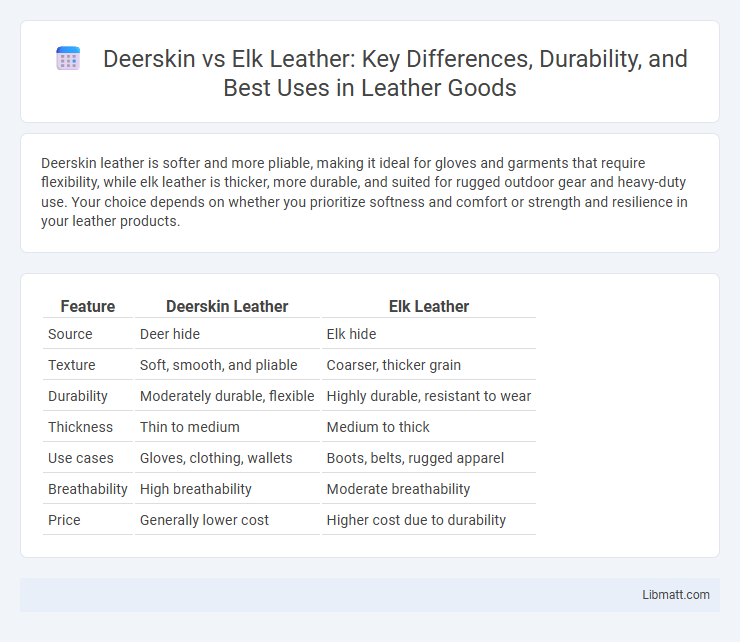Deerskin leather is softer and more pliable, making it ideal for gloves and garments that require flexibility, while elk leather is thicker, more durable, and suited for rugged outdoor gear and heavy-duty use. Your choice depends on whether you prioritize softness and comfort or strength and resilience in your leather products.
Table of Comparison
| Feature | Deerskin Leather | Elk Leather |
|---|---|---|
| Source | Deer hide | Elk hide |
| Texture | Soft, smooth, and pliable | Coarser, thicker grain |
| Durability | Moderately durable, flexible | Highly durable, resistant to wear |
| Thickness | Thin to medium | Medium to thick |
| Use cases | Gloves, clothing, wallets | Boots, belts, rugged apparel |
| Breathability | High breathability | Moderate breathability |
| Price | Generally lower cost | Higher cost due to durability |
Introduction to Deerskin and Elk Leather
Deerskin leather, renowned for its exceptional softness, flexibility, and durable grain, is derived from the hide of deer, predominantly sourced from North America. Elk leather, sourced from the elk species native to the same regions, offers a coarser texture with superior thickness and natural strength, making it ideal for heavy-duty applications. Both leathers are prized in the fashion and outdoor gear industries, valued for their unique tactile qualities and long-lasting wear.
Origins and Sourcing of Deerskin and Elk Leather
Deerskin leather originates primarily from North American and European deer species, sourced through sustainable hunting and regulated farming practices to ensure ecological balance. Elk leather, derived from elk native to North America and parts of Asia, is obtained predominantly through wild population management and controlled ranching, emphasizing durability and natural grain quality. Both leathers reflect their unique animal characteristics, with deerskin offering exceptional softness and elk leather prized for its robustness and distinct texture.
Texture and Feel: Deerskin vs Elk Leather
Deerskin leather is renowned for its exceptionally soft, supple texture that becomes more supple with use, offering a smooth, buttery feel ideal for gloves and apparel. Elk leather, in comparison, has a coarser grain with a slightly firmer texture, providing durability while maintaining a soft, natural feel that is thicker yet flexible. Both leathers are prized for their breathability and natural oils, but deerskin excels in softness while elk leather is valued for its robustness and unique grain pattern.
Durability and Strength Comparison
Deerskin offers excellent softness and flexibility but is generally less durable than elk leather, which is known for its superior strength and resilience. Elk leather features a tighter grain structure, making it more resistant to wear, tears, and stretching, ideal for long-lasting use in tough conditions. You can choose elk leather for durability and strength when seeking rugged, hard-wearing materials, while deerskin suits applications prioritizing comfort and suppleness.
Flexibility and Comfort: Which is Superior?
Deerskin offers unparalleled flexibility due to its fine grain and thin fibers, making it exceptionally soft and comfortable for prolonged wear. Elk leather, while still supple, tends to be thicker and more durable, providing a balance of comfort and ruggedness but less pliability than deerskin. If superior flexibility and a soft hand feel are your priorities, deerskin is generally considered the better choice for comfort.
Breathability and Weather Resistance
Deerskin offers superior breathability thanks to its soft, porous structure, allowing moisture to escape and keeping Your skin comfortable during extended wear. Elk leather, while less breathable, excels in weather resistance with its dense grain providing better protection against wind and water. Choosing between the two depends on whether You prioritize ventilation or durability in various weather conditions.
Aesthetic Differences: Appearance and Finish
Deerskin leather features a supple, smooth surface with a fine grain that offers a matte finish, highlighting its natural softness and flexibility. Elk leather exhibits a coarser, more pronounced grain pattern with a slightly glossy finish, providing a rugged and durable appearance. The distinct textural variance between deerskin's delicate, velvety look and elk's robust, textured finish defines their aesthetic appeal in leather goods.
Popular Uses in Fashion and Accessories
Deerskin leather is highly favored in fashion for its softness and flexibility, making it ideal for gloves, jackets, and high-end handbags that require a supple touch. Elk leather, known for its durability and rugged texture, is commonly used in accessories like belts, boots, and wallets that benefit from its strength and natural grain. Your choice between these leathers depends on whether you prioritize the delicate finish of deerskin or the robust, textured appearance of elk leather in your fashion items.
Price and Accessibility of Deerskin and Elk Leather
Deerskin leather typically costs less than elk leather due to its wider availability and more common sourcing from white-tailed deer populations. Elk leather, known for its durability and unique texture, is rarer and usually priced higher, reflecting the limited supply and specialized harvesting practices. Your choice may depend on the willingness to invest in premium materials and the accessibility of suppliers in your region.
Choosing the Right Leather: Deerskin or Elk?
Deerskin offers exceptional softness and flexibility, making it ideal for gloves and garments requiring delicate touch, while elk leather provides superior durability and a more rugged texture, perfect for heavy-duty items like boots and jackets. Consider your project's need for softness versus toughness, as elk leather's thicker grain withstands wear better, whereas deerskin's smooth feel enhances comfort and dexterity. Your choice should align with the specific functional demands and aesthetic preferences of your leather product.
Deerskin vs elk leather Infographic

 libmatt.com
libmatt.com